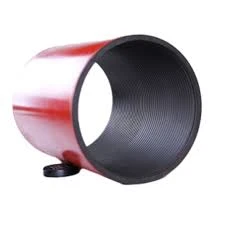well casing coupling
Well Casing Coupling An Overview
In the oil and gas industry, the integrity of a well is paramount to ensure safe and efficient extraction of resources. A critical component in well construction is the casing, which is a series of pipes that are inserted into the borehole to stabilize the well walls and prevent contamination of groundwater. An essential part of this system is the well casing coupling, which ensures that the individual lengths of casing pipes are securely connected.
What is Well Casing Coupling?
Well casing coupling refers to a mechanical device used to connect two sections of casing together. The coupling is typically a short piece of pipe that has threads on both ends, allowing it to be screwed onto the threaded ends of casing pipes. The design and materials used for couplings are crucial, as they must withstand the extreme pressures and conditions encountered during drilling operations.
Types of Couplings
There are various types of couplings used in well casing, categorized based on their design and application. The most common types include
1. Regular Couplings Standard types designed for use in drilling operations, providing basic connection functionality. 2. Screwed Couplings These are characterized by a threaded design that allows for easy attachment and detachment, making them suitable for temporary systems or maintenance purposes. 3. Welded Couplings For situations demanding a stronger connection, welded couplings are used. They are permanently attached and provide enhanced strength, making them ideal for high-pressure environments. 4. Specialty Couplings In some cases, couplings are designed for specific applications, such as those that require additional insulation or protection against corrosive environments.
Materials Used in Couplings
The materials from which well casing couplings are made must be robust and resistant to the extreme conditions encountered during drilling. Common materials include
well casing coupling

- Steel The most utilized material due to its strength and durability
. Steel couplings can be further treated or coated to resist corrosion.- Alloys In more aggressive environments, special alloys may be used to provide enhanced resistance to harsh drilling conditions.
- Plastic In certain applications, particularly in shallow or less demanding environments, high-grade plastic couplings may be used due to their lightweight nature and resistance to corrosion.
Importance of Well Casing Couplings
The integrity of the entire well is highly dependent on the quality and reliability of the couplings used. A failure in the coupling can lead to catastrophic results, including the collapse of the well, contamination of surrounding soil or groundwater, and potential safety hazards for personnel involved in drilling operations. In addition, well casing couplings play a vital role in maintaining hydrostatic pressure, which is essential in preventing blowouts and controlling well fluids.
Installation and Maintenance
Proper installation of well casing couplings is crucial. The threads must be properly aligned and tightened to avoid issues such as leaks or disconnections during drilling. Regular inspection and maintenance should also be conducted to ensure that couplings remain in good condition and are not subjected to excessive wear or corrosion.
Conclusion
In summary, well casing couplings are critical components in the oil and gas industry, serving as the connectors that ensure the integrity and stability of well casings. Understanding the various types, materials, and importance of these couplings can aid in making informed decisions regarding well construction and maintenance. As drilling technology continues to evolve, ongoing innovations in the design and materials of well casing couplings will enhance the efficiency and safety of resource extraction, ultimately benefiting the industry as a whole. It is imperative to invest in high-quality couplings and adhere to best practices in their installation and maintenance to mitigate risks associated with well operations.
-
Choosing the Right Pup Joint Manufacturers for Oil and Gas OperationsNewsAug.22,2025
-
Tubing Coupling: The Small Connector with a Big ImpactNewsAug.22,2025
-
Tubing Crossover: The Essential Connector for Well IntegrityNewsAug.22,2025
-
Precision Flow Control in Well CompletionsNewsAug.22,2025
-
Casing Pup Joint for Optimal Well PerformanceNewsAug.22,2025
-
Reliable Connections with Wholesale Finished Casing CouplingNewsAug.22,2025







